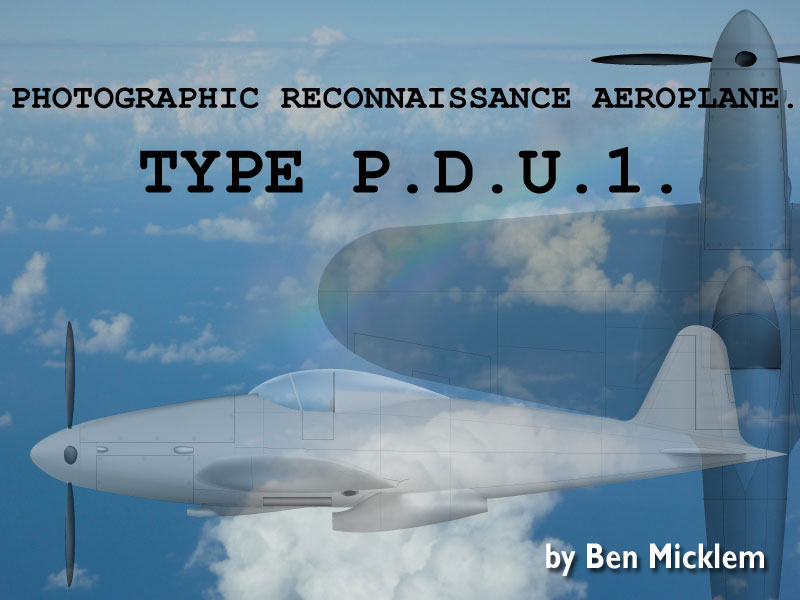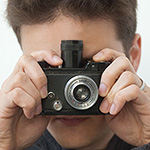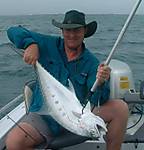P.D.U.1
British developments at the outbreak of WW2
Sidney Cotton was recruited by the British Secret Intelligence Service to fly clandestine photographic flights over Germany, before the outbreak of the Second World War. He used business trips for his colour film company, Dufaycolour, as cover. These flights were made in Lockheed 12a aircraft, mainly G-AFTL, and a Beechcraft C-17R, G-AESJ. A Canadian, Bob Niven, was his co-pilot, and also flew some of these flights. The flights of the Lockheed have become famous- such as Cotton activating the cameras while giving a senior Nazi the controls during a pleasure flight ("Don't worry about that flashing green light on the instrument panel- it just means the film... erm... fuel is running fine")- a flight over important industrial and military targets that wouldn't have been granted but for the VIP on board.A less well known flight was by Bob Niven in the Beechcraft on the eve of war, quite literally- the evening of 2nd September. The target was the German ships in Wilhelmshaven, and the photographs confirmed which ships were present. These ships were bombed by the RAF, with little success and heavy causalities on the 4th September (there was low cloud, 7 of 29 bombers didn't return). Had the RAF swallowed its pride, and acted on this intelligence, and not insisted on sending a Blenheim to confirm it themselves the next day, the bombers could have taken advantage of clear weather on the 3rd, and the first British offensive action of the war could have been more effective.
Cotton's organisation grew, and became slightly more official, after war was declared. In January 1940 it took over a lot of the responsibility for photographic reconnaissance from the regular RAF. Cotton had developed techniques for photography from high altitude, and alongside Maurice 'Shorty' Longbottom, championed the concept of using fast, single seat aircraft. After a struggle, they were able to get their hands on Spitfires. The results of this rapid development of photographic reconnaissance can be seen in the numbers below.
"To June 15th 1940
| Area Photographed | Aircraft losses | Approx. Cost | Personnel Losses | |
| R.A.F. Units (up to the end of Jan) | 2,500 sq. miles | 21 | £630,000 | 63 |
| P.D.U. [Cotton's Photographic Development Unit] | 130,000 sq. miles | 3 | £48,000 | 3 |
| German | Various points in England | 50 | £1,500,000 | 200 |
| French | 6,000 sq. miles | 60 | £1,200,000 | 180 |
Had the Regular R.A.F. Units continued to carry out the photographic reconnaissance flights incurred in covering an area of 130,000 square miles, the losses would have been in excess of 1,092 aircraft, carrying crews of 3,276 men. Cost of aircraft alone would have been over £32,000,000." (Source: Letter from Cotton to Air Vice Marshall Peck, dated July 5th, 1940)
As well as the choice and conversion of aircraft, Cotton's contributions included: introduction of meticulous planning of flights, so nothing was left to be decided in the air; pushing for development of better photographic emulsions (he had run a colour film company before the war); better cameras and fully automated film development; and he gathered experts and equipment in interpreting photographs (he had previously carried out arial surveys of Newfoundland).
The interpretation of photographs was taken to a level not conceived of previously- stereo pairs of photographs were examined to give a depth cue to the interpreter; from knowledge of the position of the sun, the length of shadows were used to measure heights; the speed of ships was measured by the spacing of the waves of their wash; and most importantly, regular covers of all important sites allowed much deeper knowledge of enemy activities- such as the build-up of invasion fleets, and the exact rate of U-boat and aircraft production.
Sidney Cotton had many contacts in high places (up to and including Winston Churchill), but also had many enemies, particularly in the more conservative ranks of the RAF and the Air Ministry. In March 1940, at the height of his influence, and when his success was in clear contrast to that of the regular RAF, he proposed the development of a Photographic High Speed Aeroplane, P.D.U.1.
Details (or even a mention) of this proposal, as far as I know, have never before been published. What follows on the next page is the complete proposal.











